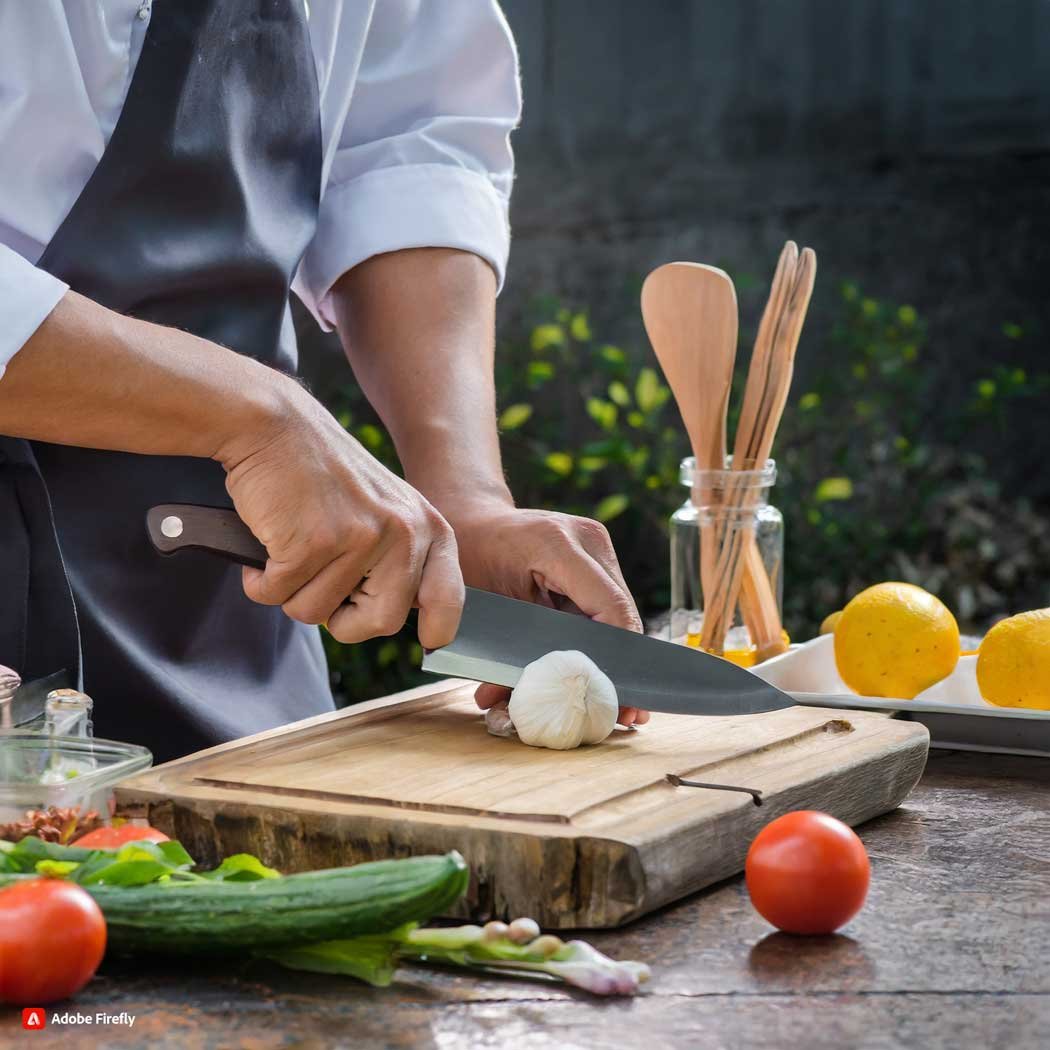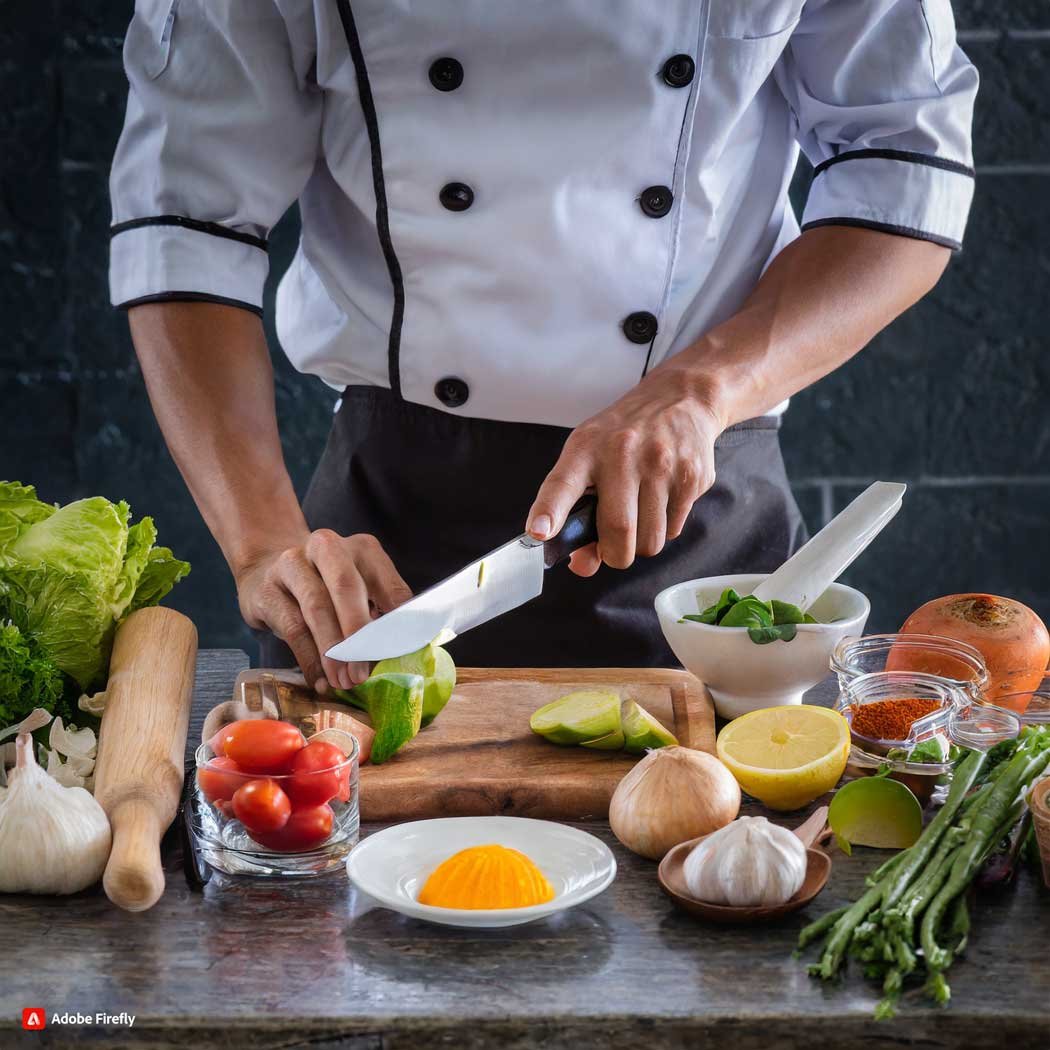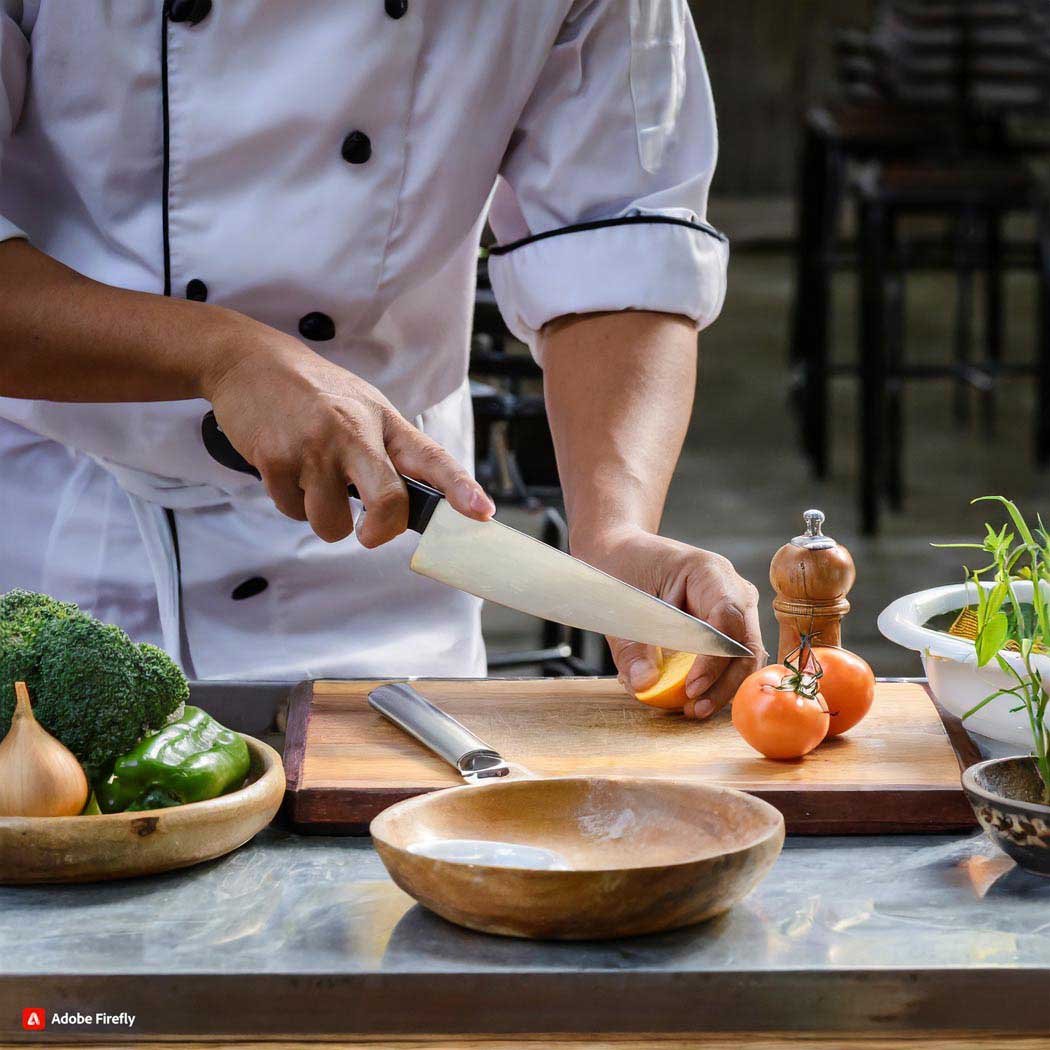Knife skills are an essential part of cooking, and mastering them can greatly improve your efficiency and precision in the kitchen. Whether you are a beginner or an experienced home cook, there are five basic knife techniques that you should master to elevate your cooking game.
5 Essential Knife Techniques Every Home Cook Should Master
The first and most important technique is the proper way to hold a knife. Many people hold a knife with their fingers wrapped around the handle, but this can lead to a lack of control and precision. The correct way to hold a knife is to grip the handle with your dominant hand, with your thumb and index finger on either side of the blade. Your other fingers should wrap around the handle for support. This grip allows for better control and reduces the risk of injury.

Once you have mastered the grip, the next technique to focus on is the proper way to chop. Chopping is a fundamental skill that is used in almost every recipe. To chop effectively, start by placing the tip of the knife on the cutting board and use a rocking motion to move the blade up and down. Keep your non-dominant hand on top of the food, using your fingers to guide the knife and keeping them curled under for safety. This technique allows for even and consistent cuts, making your food look more professional and cook more evenly.
Another important technique is the slice. Slicing is used for cutting larger pieces of food into thinner, more manageable pieces. To slice, start by holding the food with your non-dominant hand and use a sawing motion with the knife to cut through the food. It is important to keep the tip of the knife on the cutting board and use your fingers to guide the knife. This technique is especially useful for cutting meats and vegetables for stir-fries or salads. Read easy Healthy Lunch for Weight Loss.
The fourth technique to master is the julienne. Julienne is a French term for cutting food into thin, matchstick-like pieces. This technique is commonly used for vegetables such as carrots, zucchini, and bell peppers. To julienne, start by cutting the food into thin slices, then stack the slices and cut them into thin strips. This technique requires a sharp knife and a steady hand, but once mastered, it can add a beautiful touch to your dishes.

The final technique to master is the dice. Dicing is similar to julienning, but the pieces are smaller and more uniform. This technique is commonly used for ingredients such as onions, garlic, and potatoes. To dice, start by cutting the food into thin slices, then stack the slices and cut them into small cubes. This technique requires precision and practice, but it can greatly improve the appearance and texture of your dishes.
In addition to these five essential techniques, there are a few tips that can help improve your Knife skills. First, always use a sharp knife. A dull knife not only makes cutting more difficult, but it also increases the risk of injury. Invest in a good quality knife sharpener and make sure to sharpen your knives regularly. Second, use a cutting board that is stable and won’t slip while you are cutting. A damp paper towel or kitchen towel placed under the cutting board can help keep it in place. Finally, always practice safety when using knives. Keep your fingers curled under and away from the blade, and never leave a knife unattended on the counter.
In conclusion, mastering these five essential knife techniques and following these tips can greatly improve your cooking skills and make your time in the kitchen more enjoyable. With practice and patience, you can become a pro at chopping, slicing, julienning, dicing, and more. So next time you are in the kitchen, remember to hold your knife correctly, use the proper techniques, and always prioritize safety. Happy cooking!
The Importance of Proper Knife Grip and Hand Placement

When it comes to cooking, having good Knife skills is essential. Not only does it make the process more efficient, but it also ensures safety in the kitchen. One of the fundamental aspects of Knife skills is proper grip and hand placement. In this article, we will discuss the importance of mastering these techniques and how they can improve your overall cooking experience.
First and foremost, let’s talk about the grip. Many people tend to hold a knife like they would hold a hammer, with their fingers wrapped tightly around the handle. However, this is not the correct way to hold a knife. The proper grip is known as the “pinch grip,” where the thumb and index finger pinch the blade just above the handle. This grip allows for better control and precision when cutting. It also reduces strain on the wrist and arm, making it easier to handle the knife for extended periods.
Another crucial aspect of proper knife grip is to make sure your fingers are curled under, with the knuckles acting as a guide for the blade. This technique is known as the “claw grip.” It may feel awkward at first, but it is the safest way to hold a knife. By keeping your fingers curled, you are less likely to cut yourself if the knife slips. It also allows for more control over the knife, preventing it from wobbling or slipping while cutting.
Now that we have discussed the grip, let’s move on to hand placement. When using a knife, it is essential to have a stable and secure base for your cutting hand. This means keeping your non-dominant hand on the food, holding it steady while you cut with your dominant hand. Your fingers should be tucked under, with your knuckles acting as a guide for the blade, just like in the claw grip. This hand placement allows for better control and precision while cutting, reducing the risk of injury.
It is also crucial to keep your fingers out of the way of the blade. Many people tend to curl their fingers while cutting, which can be dangerous. Not only does it increase the risk of cutting yourself, but it also makes it challenging to control the knife. By keeping your fingers tucked under, you can maintain a safe distance from the blade while still having a stable base for your hand.
In addition to proper grip and hand placement, it is also essential to use the correct knife for the task at hand. Different knives are designed for specific purposes, and using the wrong one can make cutting more challenging and increase the risk of injury. For example, a chef’s knife is ideal for chopping and slicing, while a paring knife is better for intricate tasks like peeling and trimming. Make sure to use the appropriate knife for the job to ensure efficiency and safety. Read The Beginner’s Culinary Journey.
Lastly, it is crucial to keep your knives sharp. Dull knives not only make cutting more challenging, but they also increase the risk of injury. When a knife is dull, you tend to use more force, making it more likely to slip and cut yourself. It is recommended to sharpen your knives regularly, either with a sharpening stone or by taking them to a professional.
In conclusion, proper knife grip and hand placement are essential for efficient and safe cooking. The pinch grip and claw grip provide better control and reduce the risk of injury. Keeping your fingers out of the way and using the correct knife for the task at hand are also crucial. And don’t forget to keep your knives sharp for optimal performance. By mastering these basic Knife skills, you can elevate your cooking experience and become a more confident and skilled chef in the kitchen.
How to Safely and Efficiently Cut Different Types of Produce with a Knife
Knife skills are an essential part of any cook’s repertoire. Whether you are a professional chef or a home cook, knowing how to safely and efficiently cut different types of produce with a knife is crucial. Not only does it make cooking easier and more enjoyable, but it also ensures that your food is prepared properly and evenly. In this article, we will discuss the basic Knife skills that every cook should know.
First and foremost, it is important to choose the right knife for the job. There are many different types of knives, each designed for a specific purpose. For cutting produce, a chef’s knife is the most versatile and commonly used. It has a broad, sharp blade that can handle a variety of tasks, from slicing and dicing to chopping and mincing. Make sure to choose a knife that feels comfortable in your hand and has a good grip.
Before you start cutting, it is crucial to have a stable cutting surface. A cutting board is the best option, as it provides a flat and sturdy surface for you to work on. Avoid using plates or countertops, as they can damage your knife and make cutting more difficult. It is also important to keep your cutting board clean and dry to prevent any slipping or accidents.

Now, let’s move on to the actual cutting techniques. The first and most basic technique is the “pinch grip.” This involves holding the knife with your dominant hand, with your thumb and index finger gripping the blade just above the handle. This grip gives you more control and precision while cutting. Your other hand should be used to hold the produce in place, with your fingers curled under to protect them from the blade.
When cutting round produce, such as onions or tomatoes, it is important to create a flat surface first. This can be done by cutting off a small portion of the produce to create a stable base. Then, use a rocking motion with your knife to slice through the produce. This technique is called “chiffonade” and is commonly used for herbs and leafy greens.
For larger produce, such as carrots or potatoes, it is important to use a “claw grip.” This involves curling your fingers under and using your knuckles to guide the knife. This not only protects your fingers but also allows for more control and even cuts. When slicing, make sure to keep the tip of the knife on the cutting board and use a sawing motion to cut through the produce.
Another important technique is the “julienne” cut, which creates thin, matchstick-like pieces of produce. To do this, first, cut the produce into thin slices, then stack the slices and cut them into thin strips. This technique is commonly used for vegetables like carrots, bell peppers, and zucchini.
When it comes to cutting herbs, it is important to use a sharp knife and a gentle touch. Hold the herbs in a bunch and use a rocking motion with your knife to chop them finely. Avoid using a back and forth motion, as this can bruise the herbs and affect their flavor.
Lastly, it is important to always keep your knife sharp. A dull knife not only makes cutting more difficult but also increases the risk of accidents. Invest in a good knife sharpener and make sure to sharpen your knives regularly.
In conclusion, mastering basic Knife skills is essential for any cook. By choosing the right knife, having a stable cutting surface, and using proper cutting techniques, you can safely and efficiently cut different types of produce. Remember to always use a pinch grip, create a flat surface for round produce, and use a claw grip for larger produce. With practice and patience, you will soon become a pro at cutting with a knife.
Q&A – Knife skills

1) What are the essential Knife skills for beginners?
Some essential Knife skills for beginners include proper grip and hand placement, using a sharp knife, and practicing safe cutting techniques such as the “claw” grip to protect your fingers.
2) How can I improve my Knife skills?
To improve your Knife skills, you can practice regularly, watch tutorials or take a cooking class, invest in a good quality knife, and learn different cutting techniques for various ingredients.
3) What are some common mistakes to avoid when using a knife?
Some common mistakes to avoid when using a knife include using a dull blade, cutting towards your hand instead of away from it, and not using a cutting board. It is also important to avoid distractions and maintain focus while using a knife.
Conclusion
In conclusion, basic Knife skills are essential for any cook or chef, whether they are a beginner or an experienced professional. These skills not only improve the efficiency and speed of food preparation, but also ensure safety in the kitchen. By mastering basic knife techniques such as proper grip, cutting and chopping methods, and knife maintenance, one can elevate their cooking abilities and create delicious and visually appealing dishes. With practice and patience, anyone can develop these skills and become a more confident and skilled cook. So, it is important to invest time and effort in learning and perfecting basic Knife skills for a more enjoyable and successful cooking experience.
Please follow us on linkedin. You can learn all best canadian food recipes you can check our Culinary 1TouchFood Youtube and Telegram 1TouchFood page. Don’t forget Fighting Obesity Magazine and Radio Cooking.

